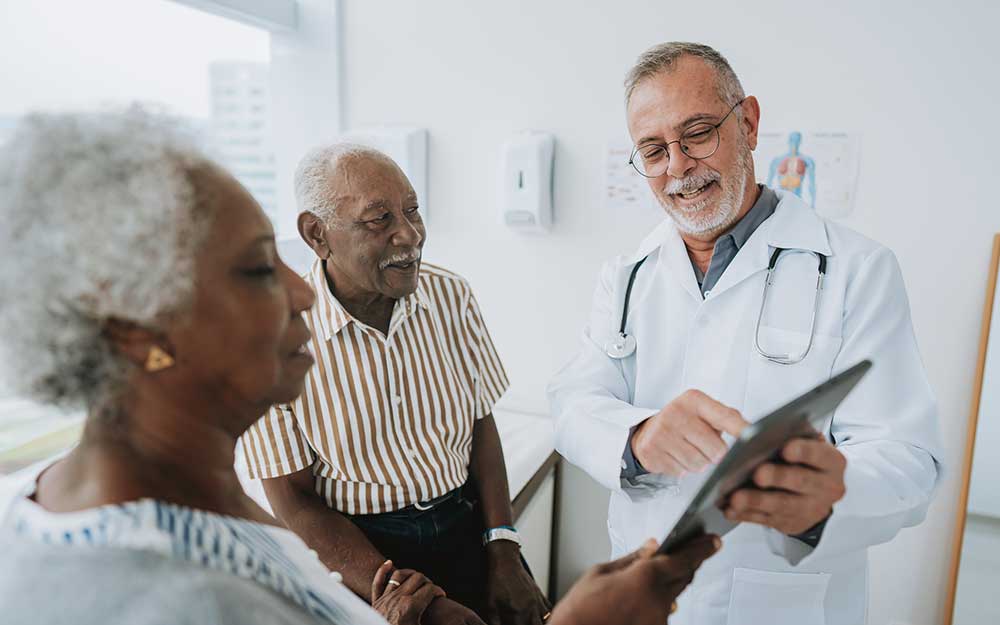Protecting Health Span as Important as Protecting Lifespan
Date
February 6, 2025

Date
February 6, 2025
Credits
Medical providers featured in this article


In Brief
{{cta-block}}
Doctors treat patients—that’s the job: set a broken bone, prescribe antibiotics for a bacterial infection, suture a cut.
But it’s not always that straightforward. Some treatments, such as chemotherapy or surgery, can cause serious side effects, particularly for elderly or frail patients. Then a difficult decision must be made: Are the side effects of the treatment worth its benefits? Will the patient’s quality of life be reduced too much to justify a challenging treatment? Will the patient live long enough to benefit?
Making these decisions can be challenging, and good doctors can disagree on what is an appropriate treatment and what amounts to overtreatment.
Many men die with prostate cancer, not from prostate cancer."
– Robert Figlin, MD
What Overtreatment Looks Like—the Case of Prostate Cancer
About one in eight American men is diagnosed with prostate cancer; it’s the second most common cancer. But many cases are slow-growing and pose no immediate danger to the patient.
“Many men die with prostate cancer, not from prostate cancer,” said oncologist Robert Figlin, MD, deputy director of Cedars-Sinai Cancer, and deputy director of the Samuel Oschin Comprehensive Cancer Institute.
Nevertheless, a recent study by researchers at the Cedars-Sinai Department of Urology found many men with a limited life expectancy were being treated with radiation therapy or surgery for prostate cancer. These patients risked urinary incontinence, erectile dysfunction and other side effects, even though many were unlikely to live long enough to enjoy any benefits from the treatment.
Figlin cites the example of a patient he first saw ten years ago. The man was in his 70s and had been diagnosed with low-grade prostate cancer.
"The conversation we had was, 'The urologist said I should have it cut out. The radiation oncologist said I should have it irradiated. What do you think, Doctor Figlin?’ I said, ‘I think you should see what the pace of your disease is without intervening immediately.'"
Figlin reports the man is now in his mid 80s. He continues to have localized prostate cancer, has never had it treated and is leading an active and full life.
"Many men with prostate cancer don’t need radiation. They don’t need surgery. They need observation," said Figlin. "And yes, in time they may need something further, but not immediately."
{{providers}}
Finding the Right Balance Between Quality of Life and Treating Disease
"The most important thing is the patient’s individual goals and preferences," said Sonja Rosen, MD, chief of Cedars-Sinai Geriatric Medicine and medical director of geriatrics at the Cedars-Sinai Medical Care Foundation. “Care really has to be individualized. It’s finding out what matters most to my patient, and that requires a lot of informed, shared decision-making.”
When these kinds of decisions have to be made, most physicians welcome patients’ participation, said Figlin. The problem is many patients don’t have the medical background to participate equally in the conversation.
"When they walk in the door of a cancer doctor, they’re saying, 'Doctor, they’re telling me I have a life-threatening disease. How are you going to fix me?'"
To balance that conversation and give the patient agency in decision-making requires educating them about the disease and the full spectrum of treatment—or non-treatment—available.
That can take time.
"It often takes the doctor and the patient multiple sessions with which to gain the understanding of what the patient wants and what the doctor has to offer," said Figlin. "And as long as the disease is not progressing rapidly, you have the time to do that."
He recommends patients come to their first few appointments with a family member or caregiver, and even a recording device.
"It's just too hard for a cancer patient to listen to a complex conversation that is ultimately something that threatens their comfort and longevity. They simply can’t take it all in at once."
And these decisions are not always made by just the doctor and patient. Family members can also weigh in, and their concerns may be quite different, noted Figlin.
"Will I have to change my job, bring additional healthcare providers into the house? Will I be without a significant other soon? Will I be able to navigate the economics of it and the physical nature of the caregiving?"
Sometimes the patient can’t speak for themselves, and family members have to make serious treatment decisions for them, said Rosen, and that can be very stressful.
"I like to ask, 'Setting aside what you want for your mom or your dad, what do you believe your dad or mom would want for themselves?' And that often helps remove that burden of responsibility," she said.
The Age Factor and Undertreatment
Age can be an important consideration when deciding how or if to treat a health condition. Nevertheless, Rosen insists these decisions should be personalized for each patient, not based on sociocultural norms about age that can lead to undertreatment for older patients.
"I do still see paternalism and ageism," she said. "It's not malicious intent. It’s just this kind of bias: ‘I know what’s best.’ And we’re not asking the patient."
Rosen offers this example: The United States Preventive Services Task Force recommends mammograms for women between the ages of 40 and 74. But the risk of breast cancer—the most common form of cancer—increases with age, so why automatically stop testing at 75?
"The American Cancer Society says it makes sense to continue screening mammograms if you have a life expectancy of five to 10 more years. A healthy, high-functioning 80-year-old woman can live at least 10 more years," Rosen said.
Providers who simply go by the recommended ages often do not offer a mammogram to women past the age of 74.
"I ask, 'If you found something abnormal on the mammogram, would you want to do something about it?'" said Rosen. "And nine times out of 10, a healthy, high-functioning woman who has a good quality of life, good health, would say, ‘Yeah, of course I want to do something about it.'"
According to Rosen, these treatment questions can become trickier to navigate when patients are cognitively impaired.
"There is definitely heightened awareness about patient rights and responsibilities," she said. "And everyone is thinking, 'What does this patient want? What does my loved one want?' But the answer is not always obvious."
Who Makes the Organ Transplant Decision?
Transplantation is unique because it involves a multi-layer approval process. Not only do the patient and doctor need to agree on the treatment, but since there are seldom enough organs to fill the need of waiting patients, a multi-disciplinary panel determines which patients are most likely to tolerate the transplant.
"We have to make sure that we select patients we think will be able to recover," said transplant surgeon Steven Wisel, MD, interim surgical director of Pancreas Transplantation at Cedars-Sinai. "We don’t want to commit them to a life of frailty after this enormous operation."
But for those who are strong enough, the operations are often lifesaving.
"We know that if you can tolerate it without major complications, the survival and the quality of life are excellent," said Wisel. "So, for us surgeons, the struggle is always: How do we get the most patients transplanted?"
When it comes to age, Wisel agrees with Rosen that each patient must be evaluated individually. He says Cedars-Sinai does not set upper age limits on transplantation.
"The oldest kidney transplant I’ve ever done was in a marathon runner approaching 90 years of age," said Wisel. "Well…by 85 he’d switched to half marathons."
The Balance Point Keeps Moving
New science and technology continually improve treatment options and move the line of what’s possible and appropriate.
The development and refinement of immunosuppression drugs, for example, have made transplantation a viable option for many more patients.
"The one-year survival rate for a liver transplant used to be about 20 percent," said Wisel. "These drugs really made liver transplants feasible."
"I'm not caring for patients the same way I did 40 years ago when I started my career," agreed Figlin. "Everything that I’m doing today is based upon the evolution of science that I and others have contributed to."
But patients’ understanding, he explained, often lags behind medical evolution, because it takes time for society to catch up.
"We don’t do a good enough job educating people,” said Figlin. “So, at the end of the day, we have to do that on a one-on-one basis with the patient there in front of us."






